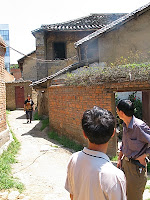Coming of Age, 1972: Episode #10
Saturday, November 05, 2022
The night ferry from Dublin brought me to Holyhead, at dawn. From there I set my feet for London, hoping to find waiting mail. The Welsh countryside was beautiful, and the street signs entertained me with names like Llanfairpwllgwyngyll, Glyndyfrdwy, and Brynsaithmarchog. Holyhead sits on an island, connected to the British ‘mainland’ by the world’s oldest major suspension bridge.
It was a pleasant day. By walking some and getting a few rides, I covered about 150 miles before sundown.
I only skirted the outlying districts of Birmingham, rendered magical by yellow street lamps in a slight fog. I don’t remember where I thought I might get to spend the night, but a lorry driver stopped and offered me a ride. I’ve had readers in the British Isles for eleven days now, so we might as well use the correct vocabulary. There are no truck drivers in England, only lorry drivers.
We drove the M-40 the rest of the night, and the conversation was good. Not long before dawn, he dropped me on the outskirts of Winchester, and I rolled out my sleeping bag in a recently mowed cornfield. I might have slept a couple of hours, and the sun was up when I awoke.How often does one get to Winchester? I thought I ought to get a look at the famous cathedral before I returned to my pursuit of any letters waiting for me in London. As an inveterate whistler, as I walked I whistled The New Vaudeville Band’s 1966 whistling hit “Winchester Cathedral.”
I walked naively into Winchester and took a nice look at the first big church I came to. Yeah, it was nice, if maybe not worthy of all the hype I had heard. Then, thinking I could check-off Winchester from my bucket list, I started across the city to reach the highway north. In the process, I stumbled upon the C*A*T*H*D*R*A*L. Boy-oh-boy. The laugh was on me.
I spent a goodly amount of time properly appreciating an amazing feat of architecture, built between 1079 and 1532. The interior length runs a football field and a half, with burials from an even earlier building, as far back as Cynegils, King of Wessex (AD 611–643). More recently, the Cathedral contains the remains of Jane Austin
When finally I had seen enough of the Cathedral—and seeing on the map that I was only a couple of miles from Tichborne—I hiked out of Winchester on the M-31.
In England, I could not have repeated the details, but I recognized the name had been important on my family tree. Refreshing my memory as I write this, John Tichborne (1460 - 1498), born at Tichborne, had one son, Nicholas (b. abt. 1480 and recorded as “Burgess of Hindon,” living at Tisbury, about 50 miles west of Tichborne) who sired Dorothy (abt. 1510 - abt. 1572), who married John Sambourne. Their grandson Richard (1580 - abt. 1632) married Ann Bachiler. After Richard’s death, their three sons crossed the Atlantic with their maternal grandfather, the Rev. Stephen Bachiler, and settled in Massachusetts, thereby planting my mother’s family in America.
Several days ago, when I began writing this episode, I had no idea I would be posting this on Guy Fawkes Day, nor any intension of mentioning the religious struggles of the 16th and 17th Centuries. Yet as I poked around on the web, it couldn’t help but come up.
Richard Samborne would have been distantly related to Chidiock Tichborne (1562 –1586), who was executed at age 23 for his part in the Babington Plot, a conspiracy by a small group of Catholics who hoped to murder Queen Elizabeth I, and replace her with Mary, Queen of Scots. Chidiock left behind a wife, a daughter, and three poems that can still be found in print. Other than Chidiock, the Tichborne family were able to remain Catholic and even (by concession of King James I) retain as Catholic their family chapel inside the Church of England St. Andrew’s Church in Tichborne. On the other hand, the same King James I took lands and livelihood away from Rev. Stephen Bachiler, a “notorious inconformist.” There are hints that his Bachiler line arrived in England as Huguenot refugees from the slaughters in France. It makes sense that Stephen Bachiler (1561-1656) was an early proponent of the separation of church and state in American Colonies.
In Tichborne, I found the village library and went in, but had no idea what I might find, or how to go about it. Year’s later, I discovered Tichborne’s Elegy.
Tichborne’s ElegyMy prime of youth is but a frost of cares, My feast of joy is but a dish of pain, My crop of corn is but a field of tares, And all my good is but vain hope of gain; The day is past, and yet I saw no sun, And now I live, and now my life is done.
My tale was heard and yet it was not told, My fruit is fallen, and yet my leaves are green, My youth is spent and yet I am not old, I saw the world and yet I was not seen; My thread is cut and yet it is not spun, And now I live, and now my life is done.
I sought my death and found it in my womb, I looked for life and saw it was a shade, I trod the earth and knew it was my tomb, And now I die, and now I was but made; My glass is full, and now my glass is run, And now I live, and now my life is done.
After sitting in the library for a short time, I caught a ride into London. My strongest memory is passing Wimbledon. I don’t follow tennis, but I recognized the name.
Labels: 1972, Anecdotes, England, Europe, Genealogy, History, Memoir, Travel, Wales












